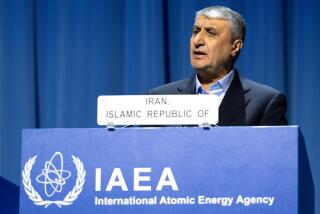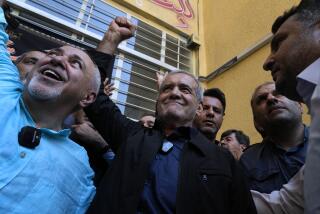Many Yearn for Western Democracy : Not All Iranians Cheer for Islamic Regime
- Share via
TEHRAN — “In the 1970s, I was one of those students in the streets with his fist in the air,” the young professional said. For him, those were the days of sloganeering--”Death to the shah”--and of a young leftist’s dream of a socialized republic in Iran.
This young professional, call him Amir, had been away from Iran eight years by the time Shah Mohammed Reza Pahlavi was overthrown. When Amir returned in 1980 to participate in the triumph of building a new nation, his buoyant expectations collided with the reality of what Iran was becoming: a revolutionary Islamic state.
Today, Amir makes a living and makes do under a government that he considers foreign to his interests. He distills his own moonshine for small, private cocktail hours and trades intelligence and rumors in a clandestine circle of friends about politics, the economy and religion in this overwhelmingly religious society.
Most of all, Amir and his circle of friends debate the future of Iran.
Monarchists, Socialists
A walk along the crowded sidewalks of Tehran turns up not only fervent backers of the Islamic state but monarchists who yearn for the days of the shah, socialists like Amir and others who yearn for a Western-oriented democracy.
For this reporter, who has traveled to both Iran and Iraq in this critical season of the two nations’ 6-year-old war, the most striking feature of the Iranian society is that it is still in a dynamic state of defining its future.
There appears to be no monolithic Islamic state, but rather a factional society of liberals and conservatives, radicals and reactionaries, often realigning when the topic shifts from domestic to foreign policy.
Modern Iran is, at the same time, a two-tiered society. One tier is organized around the Islamic-based revolution and controls the government, communications and the public sector of the economy. The second tier, of formidable proportions, appears either neutral toward or opposed to the revolution and is absorbed in the private sector of the economy.
Currency System
The most graphic example of the two-tiered structure is Iran’s currency system. The governmental sector’s exchange rate is 72 rials to the dollar, while the private sector, or free-market rate, is 800 rials to the dollar.
Unlike Iraq, where a pervasive state security apparatus has chilled most political expression, Iranians remain irrepressibly interested in discussing the war, mullah politics and relations with the West.
“How long do you think the war will go on?” is the question many Iranians want an American visitor to answer. “America could stop this war if it wanted to,” one airport traveler said.
“The Islamic republic is very bad,” a taxi driver said.
‘We Like Americans’
“We like Americans,” a man in line at a bank said. “Tehran used to be full of nightlife and music, and it will be that way again.”
Amir, who foresaw a secular state in Iran, blames his naivete for not understanding the forces that shaped the revolution. Yet he has stayed on despite the fact that dozens of his friends and colleagues have given up and returned to Europe or America.
It is not necessarily hope that keeps Amir and his young wife, a student, in Tehran. He admitted that he still is disappointed about what Iran has become and confused about the country’s future.
He compared himself to a young American who might dream of moving to Alaska to live an idyllic life in the northern woods among the gentle and peace-loving Alaskan natives.
‘Intellectuals Lost Out’
“Of course, when you get there and expect a certain way of life, the people laugh at you,” said Amir to a handful of foreign journalists at his northwest Tehran apartment.
“When I came home, the Islamic influence was much greater than I expected, and the intellectuals had lost out during the revolution,” he said. “So I spent the next few years casting off my preconceptions and learning everything about this country from the ground up.”
In what many here see as the waning days of the aging Ayatollah Ruhollah Khomeini, many Iranians spend their time trying to envision the power structure in Iran after his death.
Even well-informed Iranians seem to know little about the mullahs and technocrats who now wield power in a government structure that is difficult to fathom from the outside.
2 Contenders for Power
Concerning the two principal contenders for power, the parliamentary Speaker, Hojatoleslam Ali Akbar Hashemi Rafsanjani, 52, and Ayatollah Hossein Ali Montazeri, 63, one finds young Iranians--even those who would prefer a secular government--aligning with one camp or the other.
“I like Rafsanjani,” said a young woman, a professional who chafes at religious requirements that make her wear a head scarf in public and go swimming fully clothed. “He is intelligent, clever and charming.”
The woman added that she senses a pragmatism in Rafsanjani that might eventually tolerate some semblance of the “good life” once again in Tehran.
Amir, meanwhile, defends Rafsanjani’s purported rival, Montazeri.
“Everyone says he’s a good-hearted man,” said Amir, challenging assertions that Montazeri is anti-Western and radical on economic issues. “He supports the peasants and he’s against the bureaucracy. In economic issues, he is a Thatcherite and, in fact, he is closer to Thatcherism than” is the British prime minister, Margaret Thatcher, herself.
More to Read
Sign up for Essential California
The most important California stories and recommendations in your inbox every morning.
You may occasionally receive promotional content from the Los Angeles Times.










